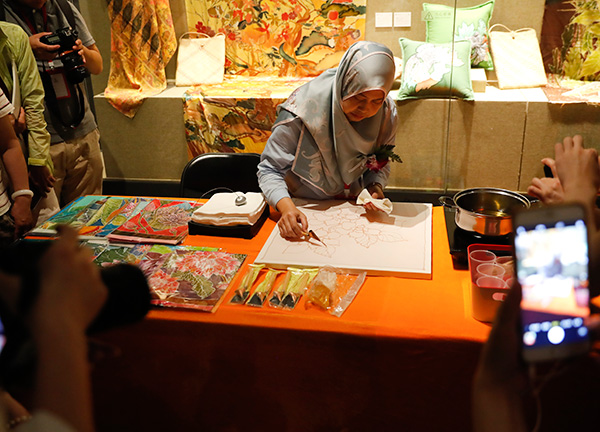 |
Malaysian artist Noor Shaibah Said demonstrates traditional batik craft of dyeing at Craftsmanship of Civilizations, an ongoing exhibition at the National Library of China.[Photo by Du Yang/For China Daily] |
The National Library of China serves as a state museum of classic books. Its vast and comprehensive collections - ranging from millennia-old oracle bones, the ancient manuscripts of Dunhuang, epigraphs and rubbings, historic documents in the languages of ethnic groups to manuscripts by renowned authors - stand as handwritten testaments to human civilization.
Now, visitors to this Beijing institution will find their experience in understanding Asian cultures diversify. In addition to flipping through texts in the library's collection, they can also visit an ongoing exhibition titled Craftsmanship of Civilizations.
The exhibition, which runs through May 28, is one of several cultural events to mark the inaugural Conference on Dialogue of Asian Civilizations that opened in Beijing on Wednesday.
Artists from 13 countries show works and designs that celebrate the variety of their own cultural accumulation, as well as a shared craftsmanship that stresses persistence, flexibility, mutual respect and learning.
At the entrance of the exhibition is a work called Bai Na Yi by Chinese artist Ma Defan. The piece of cloth in the shape of a dress is made up of different patterned textiles, which Ma says was first inspired by bainayi, a traditional Chinese way of dressmaking: "People in the old days could not afford new clothes, so they collected used and discarded scraps of fabric, cleaned them and sewed them together."
Ma adopts the form to make the dress using woven fabrics from China, Japan, Singapore, Thailand and India, which she says demonstrates distinctive dressmaking and weaving techniques, some of which can be dated back to the Song Dynasty (960-1279).
She has, however, dropped the original function of bainayi but implanted a new meaning in the work: "This dress represents those forgotten, lesser-recognized 'jewels' in the development of human society which have still found a way to survive, grow and gather together."
Ma's work embodies the central idea of the exhibition that enables Asian crafts, some fighting for their revival in modern society, to meet, exchange ideas and jointly make their voices heard.
Lacquer has been used as a favored medium for arts and crafts in Vietnam. Two Vietnamese artists, with works displayed at the exhibition, show different approaches to applying lacquer to their creations.
Do Duc Khai displays several of his lacquer paintings depicting landscapes from his hometown, old lanes and fishing villages. He says he has endeavored to add a modern touch to the centuries-old art form by choosing a more abstract style. Meanwhile, La Van Hung shows jewelry, vases and a set of animal sculptures in which he says he incorporated elements from his son's drawings.
Nivet Waevsamanais, a master artist of Thai puppetry and khon mask-making, whose work is also on show, attaches great importance to the promotion of traditional crafts to the younger generation. He says he has turned his home partly into a Thai puppet theater and workshop. He gives lectures to students and teachers at schools and also introduces modern dance and music into his puppet shows.
Fan Di'an, the exhibition's chief curator and head of Central Academy of Fine Arts in Beijing, says the exhibition is supposed to change people's stereotypical idea that these crafts, and the intangible cultural heritage they represent, are out of date. He says the visitors will find that artists are making great efforts to keep these traditions in step with people's changing tastes.
Wang Chen, vice-president of the China Arts and Entertainment Group, a co-organizer of the exhibition, says a study, a tea tasting room and a zhongtang - or living room - in the classic Chinese style (and which are decorated with artwork created by some featured artists), have been re-created at the exhibition. By doing so, it is hoped that they may help to restore and revive the Asian way of living.
"I believe that when visitors walk into such an environment, into which they find objects of intangible cultural heritage harmoniously blended, they will have a clear answer to what kind of lifestyle they truly ask for and in which kind of living environment they will feel most comfortable," Wang says.
He says a lot of the displayed artists are recognized as either national treasures or household names in their own countries. He adds that the exhibition is a good beginning for future cooperation with the cultural institutions of the featured countries who helped recommend the artists on show, and that people can anticipate further, similar exhibitions in the future, but with an even wider and more diverse selection of artworks and craft pieces on display.